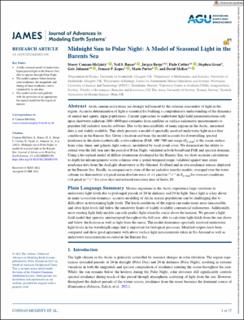| dc.contributor.author | Connan-McGinty, Stacey | |
| dc.contributor.author | Banas, Neil S. | |
| dc.contributor.author | Berge, Jørgen | |
| dc.contributor.author | Cottier, Finlo Robert | |
| dc.contributor.author | Grant, Stephen | |
| dc.contributor.author | Johnsen, Geir | |
| dc.contributor.author | Kopec, Tomasz Piotr | |
| dc.contributor.author | Porter, Marie | |
| dc.contributor.author | Mckee, David | |
| dc.date.accessioned | 2022-11-30T09:20:21Z | |
| dc.date.available | 2022-11-30T09:20:21Z | |
| dc.date.created | 2022-11-28T12:48:58Z | |
| dc.date.issued | 2022 | |
| dc.identifier.citation | Journal of Advances in Modeling Earth Systems. 2022, 14 (10), . | en_US |
| dc.identifier.issn | 1942-2466 | |
| dc.identifier.uri | https://hdl.handle.net/11250/3034937 | |
| dc.description.abstract | Arctic marine ecosystems are strongly influenced by the extreme seasonality of light in the region. Accurate determination of light is essential for building a comprehensive understanding of the dynamics of animal and aquatic algae populations. Current approaches to underwater light field parameterisations rely upon shortwave radiation (300–3000 nm) estimates from satellites or surface radiometry measurements to populate full radiative transfer software. Due to the inaccessibility of many regions in the Arctic, measured data is not widely available. This study presents a model of spectrally resolved underwater light in ice-free conditions in the Barents Sea. Given a location and time, the model accounts for downwelling spectral irradiance in the photosynthetically active radiation (PAR, 400–700 nm) range (ED PAR) at the ocean surface from solar, lunar, and galactic light sources, modulated by local cloud cover. We demonstrate the ability to extend over the full year into the period of Polar Night, validated in both broadband PAR and spectral domains. Using a bio-optical model of diffuse attenuation developed for the Barents Sea, we show accurate calculations to depth for inhomogeneous water columns over a spatial-temporal range, validated against time series irradiance data from the ArcLight observatory in Ny-Ålesund, Svalbard and in-situ irradiance sensors deployed in the Barents Sea. Finally, in comparison to state-of-the-art radiative transfer models, averaged over the water column we demonstrate a typical mean absolute error of <1 μmol m−2 s−1 in ED PAR for overcast conditions (<6 μmol m−2 s−1 for clear-sky) and reduced execution time of factor 20. | en_US |
| dc.language.iso | eng | en_US |
| dc.publisher | Wiley Periodicals LLC on behalf of American Geophysical Union. | en_US |
| dc.rights | Navngivelse 4.0 Internasjonal | * |
| dc.rights.uri | http://creativecommons.org/licenses/by/4.0/deed.no | * |
| dc.title | Midnight Sun to Polar Night: A Model of Seasonal Light in the Barents Sea | en_US |
| dc.title.alternative | Midnight Sun to Polar Night: A Model of Seasonal Light in the Barents Sea | en_US |
| dc.type | Peer reviewed | en_US |
| dc.type | Journal article | en_US |
| dc.description.version | publishedVersion | en_US |
| dc.source.pagenumber | 17 | en_US |
| dc.source.volume | 14 | en_US |
| dc.source.journal | Journal of Advances in Modeling Earth Systems | en_US |
| dc.source.issue | 10 | en_US |
| dc.identifier.doi | 10.1029/2022MS003198 | |
| dc.identifier.cristin | 2082544 | |
| dc.relation.project | Norges forskningsråd: 300333 | en_US |
| dc.relation.project | Norges forskningsråd: 276730 | en_US |
| dc.relation.project | Norges forskningsråd: 245923 | en_US |
| dc.relation.project | Norges forskningsråd: 223254 | en_US |
| cristin.ispublished | true | |
| cristin.fulltext | original | |
| cristin.qualitycode | 1 | |

